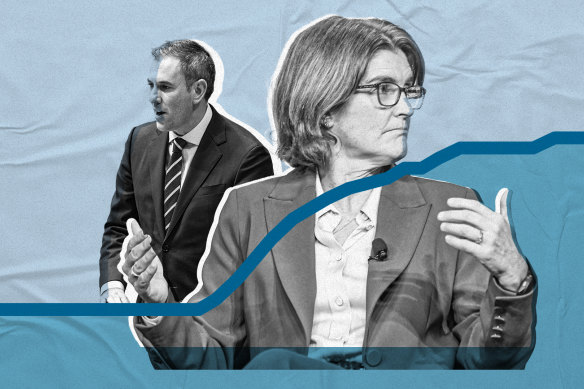Opinion
Two reasons why the RBA will have to hike rates again, and soon
Steven Hamilton
EconomistWhen the RBA board next meets, I believe there’s a better-than-even chance it will raise rates for the first time in nine months to 4.6 per cent, the highest level in nearly 13 years. And it may not be the last time.
With interest rates having already risen at a record pace and inflation already well down from its peak, you might be forgiven for wondering why further pain could possibly be necessary, particularly if you’re a mortgage holder.

Treasurer Jim Chalmers and RBA governor Michele Bullock.Credit: AFR
There are two drivers of the need for further hikes. But first, some context.
The first clear sign that inflation would be a problem came on April 27, 2022, just two weeks into the 2022 federal election campaign. The prior few inflation prints had bounced around a bit, which was chalked up to post-pandemic indigestion. But the March quarter inflation print spiked to 5.1 per cent, prompting the RBA to begin raising rates the following month. This came just a few weeks after the Coalition’s final budget, which included some big new pre-election spending.
Over the next 18 months, the RBA raised rates by 4.25 percentage points, the most rapid tightening cycle of the modern era. Meanwhile, core inflation (excluding volatile items) peaked at 7.3 per cent in December 2022 and has since fallen to 4.1 per cent.
This takes us to the first driver. We have seen enough by now to know the RBA simply hasn’t done enough to bring inflation to heel. Early on, inflation fell rapidly as supply constraints eased, but they have left sticky demand-driven inflation in their wake. The disinflation to date was despite the RBA’s stance, not because of it.
The RBA raised rates later, slower and less than its peer institutions such as the central banks of New Zealand, Canada, the UK and the US. The RBA claimed this was due to Australians’ greater use of variable-rate mortgages and a deliberate tolerance by the RBA for higher inflation for longer in a bid to preserve jobs.
On the first claim, there is no credible evidence of interest rates transmitting more directly in Australia than in other countries. This was simply speculation. On the second claim: managing high inflation is a bit like managing substance abuse – perhaps you can get away with it for a little while, but it is a dangerous game that invariably ends in disaster. Full sobriety is the only surefire remedy.
The data is crystal clear that the process of disinflation stalled at the end of last year. These are the last six monthly inflation figures since December: 4.1, 4.1, 3.9, 4.1, 4.2, 4.1. The goal is to get down to 2.5. At best, we’re going sideways.
In Australia today, interest rates are lower than in peer countries, and inflation is higher. This is no coincidence. The RBA thought they could do less and simply achieve a shallower glidepath. But that plan has failed. So rates are going to resume their ascent – at a time when they are falling in other countries.
This takes us to the second driver. On Monday of this week, the federal government began pumping roughly $43 billion of further stimulus into the economy, in addition to the tens of billions pumped in by the states. The degree of wanton fiscal recklessness is unprecedented in my lifetime – at least given the context.
The decisions the federal government took in its last two budgets increased the deficit in the financial year that began on Monday by $20 billion. Along with the $23 billion stage 3 tax cuts, they turned a $15 billion surplus into a $28 billion deficit.
While the RBA is trying – too gently – to ease its foot onto the brake, Australia’s governments are pushing on the accelerator. This leaves the RBA little choice but to stamp down harder lest we hit the wall.
And we shouldn’t be so naive as to think the two simply cancel out. Indeed, pushed to the limit, either the brakes burn out, or the engine explodes. I have no doubt we would have been in a better place as a nation had both sides simply been more restrained. If eventually we are forced into recession, this will be why.
Now, some have argued that we should simply give up. If a recession is the price we must pay to get inflation under control, then it’s a price not worth paying.
Aside from being clearly wrong (don’t cry for me, Argentina!), this is naive. The RBA’s ultimate objective is price stability. Inflation will return to target. The question is not if it will happen but what it will take to get it there. If a recession is what is necessary to make up for its past mistakes, that’s exactly what the RBA will do.
And those of us who urged the RBA to do more and the government to do less for the past two years were trying to avoid exactly this eventuality. Those who advocated dovish policy in the name of protecting the most vulnerable have, in fact, put them at greater risk.
If we have a recession, it will be on their heads.
Steven Hamilton is assistant professor of economics at George Washington University and visiting fellow at the Tax and Transfer Policy Institute at the ANU.